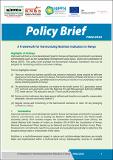| dc.description.abstract | Food security and nutrition is a major global concern and remains a policy priority in Kenya. The targets of Sustainable Development Goal 2 (SDG 2) directly address nutrition, focusing on the reduction of hunger and all forms of malnutrition such as stunting and wasting; increasing agricultural productivity; and ensuring sustainable food production systems. In Kenya, the Food Security Act (2017) and the Constitution of Kenya (2010) recognize food security and nutrition as a basic human right for every individual. The food security and nutritional status in Kenya is measured by a comprehensive Food Security and Nutrition Index. The Index is derived from an intricate analysis of food and nutrition indicators from multiple sectors including health, agriculture, water, social protection, and education, and offers valuable insights into the intricacies of food security challenges in Kenya. The overall average score on the Food Security and Nutrition Index was 0.44 – which indicates moderate food security and nutrition – with significant variations across different sectors. Health, water, and education sectors performed relatively better, whereas social protection, agriculture, and environmental management lagged.
The average health sector index was 0.65. There was a significant improvement in certain areas in the sector, for example, iron/folic acid supplementation among women and the consumption of iron-rich foods. However, the low levels of vitamin A supplementation and exclusive breastfeeding rates highlight areas that need targeted interventions. The consumption of vitamin A-rich foods among children under five (5) years improved from 38 per cent in 2016 to 41 per cent in 2022. | en |




